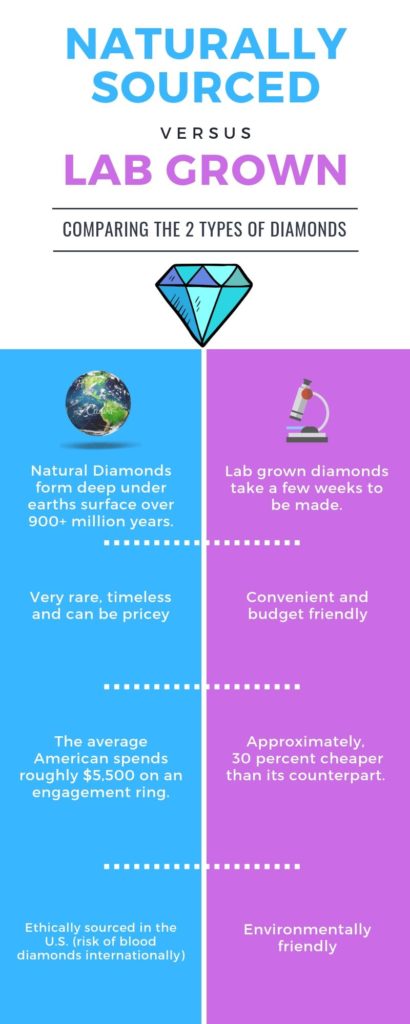Unknown Facts About Lab Grown Diamonds
Facts About Lab Grown Diamonds Uncovered
Table of ContentsThe Best Strategy To Use For Lab Grown DiamondsLab Grown Diamonds Can Be Fun For EveryoneThe Single Strategy To Use For Lab Grown DiamondsWhat Does Lab Grown Diamonds Mean?See This Report on Lab Grown DiamondsNot known Incorrect Statements About Lab Grown Diamonds
In comparison, lab-grown rubies of shade are much less pricey than equivalent extracted rubies. Their shade is intense and does not discolor. They have excellent pureness and are less complicated to find than a mined diamond of shade. If factors like environmental sustainability, knowing the origins of your gems, obtaining better top quality for a portion of the price, and having options for the color of your rubies are important to you, consider purchasing a lab-grown ruby.
Two primary techniques are used: Mimics the all-natural geological problems that form rubies. Makes use of carbon-rich gases to grow diamond crystals layer by layer.
Not known Incorrect Statements About Lab Grown Diamonds
Buyers commonly find they can buy: Larger carat weight dimensions Higher color grades Much better quality rankings all without surpassing their spending plan. It's worth noting that both extracted and developed rubies are mainly psychological financial investments.
With more developers accepting these rocks, customers will certainly gain access to distinct, creative, and ethically made precious jewelry collections. To sum up the advantages: Identical brilliance and longevity Reduced cost per carat weight Conflict-free beginning Environmentally responsible Certified for quality and authenticity Expansive layout options Created diamonds lend themselves to every sort of jewelry: From ageless solitaires to halo setups.
These designs highlight not simply the rock's radiance yet additionally the workmanship that goes into every item. The principle of accountable luxury is shaping the fashion jewelry market. Buyers are increasingly asking not simply what a diamond is, however where it comes from and how it was generated.
Lab rubies are more than just gems; they stand for the crossway of tradition and technology. By choosing these conflict-free rubies, buyers welcome luster, beauty, and responsibility in equal measure.
Lab Grown Diamonds Things To Know Before You Get This
The process of picking the appropriate ruby is certainly no walk in the park. Since there are many things you need to take into consideration prior to taking the dive and making your acquisition. We aren't simply chatting concerning what kind of style or metal you want. Prior to you even entered a jewellery store or scroll with endless pages of jewelry sites, you need to consider what cut, colour, carat weight and quality you desire your ruby to be, just how much you are looking to invest and these days, whether to get a mined or lab created diamond.
There is a consensus out there that the globe of rubies is quite black and white, but in reality, it's not that clear-cut as that as there are a lot of various kinds of rubies on the market today. There are the timeless naturally-sourced diamonds that are extracted from deep within the earth's crust.
Then there are man-made rubies that share the exact same physical residential or commercial properties as earth-mined rubies but are expanded in a lab setup that imitates the high stress and high-temperature problems a traditional ruby is grown in. Lab Grown Diamonds. While the principle of lab-grown diamonds has been around since the very early 1960s, their look in jewellery is still a reasonably new sensation
Not known Incorrect Statements About Lab Grown Diamonds

This statistic likewise differs depending on the type of diamond as well. Lab Grown Diamonds. If you were to buy an extremely uncommon pink diamond from Western Australia's recently shut Argyle mine that created over 90% of the world's fancy pink diamonds, you would be taking a look at investing a massive $140,000 to $180,000 just for one carat
lab grown pink rubies. One factor that overtakes all in the decision to choose manufactured rubies over planet rubies is that they are a lot extra green. An increasing number of individuals are ending up being mindful regarding the products they purchase, the garments that they use on their backs and a lot extra, so it's only natural that this concern has now affected the diamond purchaser's market.
Rumored Buzz on Lab Grown Diamonds
This suggests that the carbon footprint left by the naturally-mined diamond sector can be pretty substantial. Manufactured rubies, having actually been created in a controlled laboratory setting do require a reasonable little bit of power, nonetheless, compared to the degree required for the earth-mined kind the power needed is really minimal. There is an usual misunderstanding around that lab-created diamonds are the very same as simulant diamonds.
Here are some other advantages of lab-grown rubies: One point that has many people raving regarding laboratory expanded diamonds is their price tag. One aspect that manufactured diamonds are commonly constantly commended for is that they offer a bigger, brighter and often much better shimmer for a portion of the rate of naturally-mined rubies.
One variable that overtakes all in the decision to go with synthetic diamonds over planet diamonds is that they are a great deal much more eco-friendly. Even more and even more people are coming to be conscious concerning the products they acquire, the garments that they wear on their backs and a lot more, so it's just natural that this problem has currently impacted the ruby customer's market.
Unknown Facts About Lab Grown Diamonds
This implies that the carbon impact left by the naturally-mined ruby here industry can be quite vast. Synthetic rubies, having actually been generated in a controlled research laboratory setting do call for a reasonable little bit of energy, however, contrasted to the degree required for the earth-mined kind the power called for is really marginal. There is a typical misunderstanding around that lab-created rubies coincide as simulant rubies.